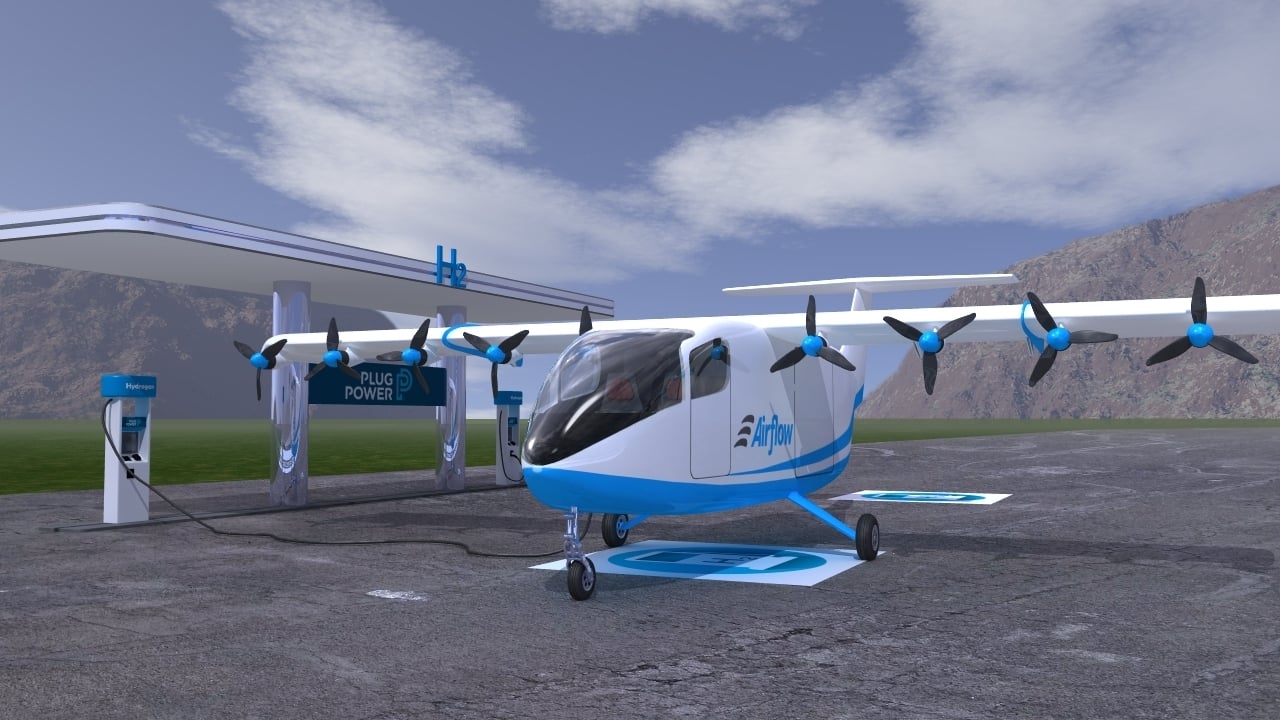Click Here to View This Page on Production Frontend
Click Here to Export Node Content
Click Here to View Printer-Friendly Version (Raw Backend)
Note: front-end display has links to styled print versions.
Content Node ID: 419372
Thanks to distributed electric propulsion, engineers now have the flexibility to design and build aircraft with capabilities unmatched by conventional airplanes. For Airflow, the key to leveraging this potential is blown-wing technology, which it is using for its proposed eSTOL vehicles.
“The key breakthrough here is electric propulsion,” says Peter Kalogiannis, co-founder and chief technology officer at California-based start-up Airflow. “What we’re doing is taking an existing technology and applying it to a new type of aircraft.”
Airflow is working on two versions of its proposed aircraft, both of which could be operated by a single pilot. One version would have eight to 10 passenger seats, a 2,000-pound payload, a 500-mile range, and the ability to land and take off from just 200 feet of runway. A smaller model would have a 500-pound payload and 250-mile range and be able to operate from a runway of only 150 feet.
At its most basic level, blown-wing, or blown-lift, technology is an aerodynamic effect: by accelerating air over the wing, it generates lift at a much slower airspeed than conventional aircraft. Kalogiannis explained to FutureFlight that when a traditionally built airplane flies at a certain speed, the air flows over the wing at the same speed. But with blown-wing technology, that same air is accelerated over the wing, meaning that even if the airplane is stopped, the air continues to move over the wing at a much higher speed.
“The key breakthrough here is electric propulsion,” Kalogiannis said. “What we’re doing is taking existing technology and applying it to a new type of aircraft. This allows us to generate lift at a much slower speed than a traditional aircraft, which is really the key to getting in and out of short airfields.”
Blown-wing technology is by no means a new concept; it’s been around since the 1960s. At that time, however, aircraft were equipped with piston or turbine engines. This meant that to get the benefits of the blown-wing concept, engineers had to link multiple rotors with mechanical shafts or duct turbine gas through the wing.
“While this worked, it was both complex and expensive, meaning these aircraft never advanced past the prototype or low-volume production phase,” Kalogiannis stated.
But electric propulsion changes everything. According to Kalogiannis, because electric motors can scale down efficiently in a way pistons and turbines can’t, they can be placed across an aircraft’s wing. “This creates the blown-wing effect, getting us all the aerodynamic benefits but in a way that makes the economics work as well,” he said.
While Kalogiannis sees some environmental benefits to retrofitting turbine aircraft with electric motors, doing so often results in a decrease in performance. “Instead, at Airflow, we’re taking advantage of the benefits of electric propulsion," he said, "essentially using it, combined with blown-wing technology, to get not only the green benefits but also an array of performance benefits."
These benefits include the capacity to carry more payload into shorter fields. They also mean engineers can size the aircraft’s wing for an optimal cruise—a feature that can increase maximum cruising speeds, decrease the energy required to achieve those speeds, and reduce operating costs.
“The beauty of this technology is that you can use it to optimize around the specific type of aircraft or the type of mission you’re looking to fly,” said Kalogiannis.
For Airflow, that’s regional/subregional aircraft geared to flying missions of around 500 miles. “Traditionally, these types of missions were limited to operating out of existing airports,” concluded Kalogiannis. “But with blown-wing technology, our electric aircraft will be able to operate from even the smallest airfields without the need for additional infrastructure.”
Last year, Airflow reported that it tripled the size of its provisional order book for the eSTOL aircraft it aims to bring to market in 2025. Recent commitments have come from operators including Ravn Alaska and Tailwind Air.
Another U.S. start-up Electra is also using blown-lift technology for its eSTOL design. In 2022, the company expects to fly a technology demonstrator of the aircraft, which is expected to carry seven or eight passengers on flights of up to around 500 miles.
